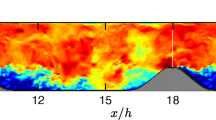Abstract
In aerodynamics, the laminar or turbulent regime of a boundary layer has a strong influence on friction or heat transfer. In practical applications, it is sometimes necessary to trip the transition to turbulent, and a common way is by use of a roughness element (e.g. a step) on the wall. The present paper is concerned with the numerical implementation of such a trip in large-eddy simulations. The study is carried out on a flat-plate boundary layer configuration, with Reynolds number Rex=1.3×106. First, this work brings the opportunity to introduce a practical methodology to assess convergence in large-eddy simulations. Second, concerning the trip implementation, a volume source term is proposed and is shown to yield a smoother and faster transition than a grid step. Moreover, it is easier to implement and more adaptable. Finally, two subgrid-scale models are tested: the WALE model of Nicoud and Ducros (Flow Turbul. Combust., vol. 62, 1999) and the shear-improved Smagorinsky model of Lévêque et al. (J. Fluid Mech., vol. 570, 2007). Both models allow transition, but the former appears to yield a faster transition and a better prediction of friction in the turbulent regime.
Similar content being viewed by others
Abbreviations
- α :
-
power-law factor
- β :
-
minus power-law exponent
- χ :
-
numerical convergence monitor
- Δx +, Δy +, Δz + :
-
cell-dimensions at wall, in wall units (streamwise, wall-normal, spanwise)
- δ :
-
boundary-layer thickness
- δ̣✩ :
-
displacement thickness
- ɛ 4 :
-
artificial viscosity coefficient
- µ:
-
dynamic viscosity
- θ :
-
momentum thickness
- ρ :
-
density
- a :
-
contravariant vector
- C D :
-
drag coefficient
- C f :
-
friction coefficient
- c :
-
speed of sound
- h:
-
cell volume
- LES :
-
large-eddy simulation
- L x , L y , L z :
-
minimum domain dimensions
- l x , l y :
-
step dimensions (length and height)
- RANS :
-
Reynolds-averaged Navier-Stokes
- Re x :
-
Reynolds number (based on axial distance)
- T:
-
static temperature
- t:
-
time
- t+ :
-
normalized time
- U:
-
mean streamwise velocity
- u :
-
velocity vector
- u, v, w:
-
velocity components (eq. u x , u y , u z )
- u w :
-
friction velocity
- x, y, z:
-
coordinates (streamwise, wall-normal and spanwise)
- x trip :
-
trip abscissa
- ∞:
-
infinity index: inflow characteristics
- —:
-
overline: mean
- ′:
-
prime: standard deviation
References
Schlichting, H., Boundary-Layer Theory. 7th edition, McGraw-Hill, New York (1979).
Cliquet, J., Houdeville, R., Arnal, D., “Application of Laminar-Turbulent Transition Criteria in Navier-Stokes Computations”, AIAA Journal, vol. 46, no5, pp. 1182–1190 (2008).
Sagaut, P., Large eddy simulation for incompressible flows, Springer, New York (1998).
D. You, M. Wang, P. Moin, R. Mittal, “Large-eddy simulation analysis of mechanisms for viscous losses in a turbomachinery tip-clearance flow”, Journal of Fluid Mechanics, vol. 586, p. 177–204, 2007.
F. Ducros, P. Comte, M. Lesieur, “Large-eddy simulation of transition to turbulence in a boundary layer develo** spatially over a flat plate”, Journal of Fluid Mechanics, vol. 326, p. 1–36, 1996.
J. Boudet, J. Caro, L. Shao, E. Lévêque, “Numerical studies towards practical large-eddy simulation”, Journal of Thermal Science, vol. 16, no4, p. 328–336, 2007.
F. Nicoud, F. Ducros, “Subgrid-Scale Stress Modelling Based on the Square of the Velocity Gradient Tensor”, Flow, Turbulence and Combustion, vol. 62, no3, p. 183–200, Sept. 1999.
E. Lévêque, F. Toschi, L. Shao, J.-P. Bertoglio, “Shearimproved Smagorinsky model for large-eddy simulation of wall-bounded turbulent flows”, Journal of Fluid Mechanics, vol. 570, p. 491–502, 2007.
A. Cahuzac, J. Boudet, P. Borgnat, E. Lévêque, “Smoothing algorithms for mean-flow extraction in large-eddy simulation of complex turbulent flows”, Physics of fluids, vol. 22, no12, 2010.
A. Jameson, “Transonic airfoil calculations using the Euler equations”, in Numerical methods in aeronautical fluid dynamics, Vol.1, Academic Press, New York, p. 289–308, 1982.
J. Cousteix, Turbulence et couche limite. Cepadues editions, Toulouse, 1989.
H. L. Dryden, “Transition from laminar to turbulent flow”, in Turbulent Flows and Heat Transfer, Princeton University Press: Princeton, New Jersey, C. C. Lin, 1959.
M. P. Simens, J. Jimenez, S. Hoyas, Y. Mizuno, “A high-resolution code for turbulent boundary layers”, Journal of Computational Physics, vol. 228, no11, 2009.
J. Jimenez, S. Hoyas, M. P. Simens, Y. Mizuno, “Turbulent boundary layers and channels at moderate Reynolds numbers”, Journal of Fluid Mechanics, vol. 657, 2010.
Author information
Authors and Affiliations
Rights and permissions
About this article
Cite this article
Boudet, J., Monier, J.F. & Gao, F. Implementation of a roughness element to trip transition in large-eddy simulation. J. Therm. Sci. 24, 30–36 (2015). https://doi.org/10.1007/s11630-015-0752-8
Received:
Published:
Issue Date:
DOI: https://doi.org/10.1007/s11630-015-0752-8



